Understanding America's New Right


Fighting for Western Civilization in someone else's back yard

Noah Smith is an economist I used to follow on Twitter. I left that site shortly after Elon bought it, and lost track of Smith, and several others.
Most of them are on Substack now.

“Now we are not outnumbered! Now WE have an army!” — Thorin
This post is going to be something a little different than usual. Most of my posts try to explain the facts of the world; today I’m going to try to explain an ideology .
You can’t really understand policymaking without ideology. This is something most commentators intuitively grasp, but many academics don’t. If you sold tax cuts in 1981 as “Keynesian demand stimulus”, you wouldn’t have gotten anywhere, but “supply-side” arguments won the day. Ideology is the way most leaders, advisors, and commentators organize their thinking about policy; it serves as a coordination mechanism to make sure that a bunch of people are basically on the same page about what they ought to do.
Here’s an example. In the recent Signal group-chat incident, JD Vance seemed obsessed with the idea of not helping Europe:
"I think we are making a mistake," Vance wrote in the Signal group with Cabinet secretaries and senior White House officials, arguing that the Houthis were more Europe's problem than America's…In the text messages, Vance said of the planned bombings: "I am not sure the president is aware how inconsistent this is with his message on Europe right now."
Why was not helping Europe even more important to the Vice President than accomplishing the operation’s actual military objectives? The only possible answer is “ideology”.
In fact, I’ve found myself using ideology as my explanation for much of what the Trump administration has done in the two months since it came to power. I explained Trump’s tariffs as an ideologically driven attempt to isolate America from foreign dependency and ape the country’s “glory days” of the pre-WW2 period. And I explained Elon Musk’s DOGE as an attempt to purge “woke” progressivism from the U.S. government and other institutions.
These aren’t all quite the same ideology. Vance, Trump, and Musk have worldviews that differ in important and consequential ways. Yet they’re all recognizably affiliated — subsets of one category that we might broadly call the New Right.
Understanding the New Right is sort of a gestalt exercise — you’re basically acting like an LLM. Listen to leaders like Vance, and mainstream media figures like Joe Rogan who have drifted to the right in recent years. Then read a bunch of people on the right and pattern-match to figure out which thought leaders folks like Vance and Rogan sound like. You’ll probably end up with influencers like Charlie Kirk and Jack Posobiec and Tucker Carlson and Auron MacIntyre , and blogs like Aporia and The Upheaval . Then try to isolate some common themes and big ideas, and see if you can use those to parsimoniously explain the attitudes and actions of leaders like Vance. 1
Anyway, here’s what I’ve come up with. This post is not an attempt to pass an “ ideological Turing test ” — to prove to members of the New Right that I understand them. 2 Nor am I trying to be judgmental here; this is neither a jeremiad against the New Right, nor an apologia for it (though some commenters will inevitably accuse it of being both of those things). There will be plenty of time for that in other posts.
Instead, in this post, I want to try to explain the New Right to people who aren’t part of it, in a way that they can productively understand.
Once this basic understanding is in place, I think a lot of the Trump administration’s seemingly boneheaded, overly risky, or counterproductive actions become less mysterious. That doesn’t mean the Trump administration isn’t incompetent, or that everything is proceeding according to some grand plan. But I think it helps clarify some of the goals the MAGA folks are trying to accomplish with things like tariffs, abandoning Europe , embracing Russia, purging the government, amassing executive power , kicking out immigrants, and so on.
“Western Civilization” is the key to the New Right
The New Right, I believe, emerged from a profound identity crisis in America. It’s an attempt to answer the basic question Samuel Huntington asked in 2005, in his book Who Are We?: The Challenges to America's National Identity . Two decades ago, immigration, globalization, and the internet were already causing Americans to question their old assumptions about the cultural, historical, and racial basis of their civilization.
When social media arrived in the early 2010s, that process went into overdrive — instead of interacting mainly with people located near them in physical space, Americans suddenly spent all their time sorting into like-minded communities online (or engaging in combat with opponents). A society already beginning to wonder if it was really a nation suddenly began to wonder if it was even a place .
The New Right was one of the rocks that some people clung to in that dizzying maelstrom. To a large-ish number of Americans, it told a coherent story about who they were, where they came from, and what commonalities tied them together. The story it told was about “Western civilization”.
When I say “Western civilization”, I don’t mean it in the Cold War sense of “the free world”. It doesn’t include Japan or Latin America, and it very much does include Russia. The Western Civilization that the New Right believes in is defined by three things: 1) European racial descent, 2) Christian heritage, and 3) veneration of the previous two things.
The third of these is absolutely the key. European descent and Christian heritage define “Western” for the New Right, but respect for those things defines “civilization”. If you created an all-white country, and it was full of blue-haired genderqueer atheist decolonial-leftist white people, that would be anathema to the New Right. 3 Trump’s administration has harassed Europeans at the border and is considering mass deportations of Ukrainians. Conversely, the New Right has few qualms about accepting Hispanic, Black , and Middle Eastern fellow-travelers. JD Vance’s wife is of Indian descent!
Nor are the New Right typically pious or born-again Christians; they can tell you what the Ordo Amoris is, but they might initially forget to receive ashes on Ash Wednesday. Christianity’s importance to the New Right is not the same as it was for the Christian Right of the 1980s and 1990s. It’s less of a guidebook to life or a locus of real-world community, and more of a source of shared heritage, and a boundary that demarcates historical Europe from the rest of the world. It’s less about Christ than about Christendom . 4
These might seem like fine distinctions, but they explain why the New Right despises Europe above all other entities. It’s because they feel that modern Europe has betrayed its own heritage.
Europe as the Fallen West
The U.S. as a whole was never racially homogeneous. Black people were always there, and they never dipped below 10% of the population. Americans in the North had frequent contact with Native American populations. California and Texas had Hispanics before they had Anglos. But in the American mind, Europe stood across the sea as a place of timeless homogeneity, where the native white population had always been and would always remain. In the 20th century, as American consciousness of ethnic differences between Poles, Italians, Germans etc. faded, perceptions of Europe as homogeneously “white” grew stronger.
In the mind of many Americans, Europe thus stood as both a refuge and a reservoir. America itself was a rough, contested frontier, but Europe would always be white and Christian. If you ever felt the need to live around a bunch of white people of Christian heritage, you could always go “back”, but for most that wasn’t necessary — just knowing that the Old World was somewhere out there was enough. 5
I think Europeans may underestimate how much this perception motivated America’s participation in the Transatlantic Alliance during the Cold War. Yes, some Americans cared about saving Western Europe for economic reasons, others cared about democracy and freedom, and many worried about the balance of power. But to conservative Americans in the 20th century — the type of people who joined the John Birch Society — the Cold War was about preserving Christendom from the threat of godless communism.
Anyway, in the 2010s, it dawned on those Americans that this hallowed image of Europe was no longer accurate. With their working population dwindling, European countries took in millions of Muslim refugees and other immigrants from the Middle East and Central and South Asia — many of whom didn’t assimilate nearly as well as their peers in the U.S. You’d hear people say things like “Paris isn’t Paris anymore.” 6
At the same time, Europe had long since abandoned its traditional Christian values; this had been true for a while, but became clearer with the international gay rights movement. On top of all that, it became apparent that Europe had made itself militarily weak through demilitarization, and economically weak through overregulation.
To Americans who valued the idea of America and Europe as part of a single Western civilization, this realization was catastrophic. Suddenly European countries — and the Anglosphere countries of Canada, Australia, and New Zealand — felt like they had left the club. In Canada, Justin Trudeau was explicitly talking about his country as a “postnational state”, with “no core identity”.
That left America as the last bastion — the last place that actually venerated its European roots and its Christian heritage. And after the Summer of Floyd in 2020, and the wokeness that seemed like the new law of the land, even that last bastion looked like it was about to fall forever. When protesters toppled statues of the founders, and the Biden administration embraced DEI, the New Right clearly saw their own country heading in the direction of Trudeau’s “postnational” vision.
Interestingly, the New Right sees the imminent fall of Western civilization as due to an inherent pathology of white people. Basically, the story is that white people are just too nice , and therefore uniquely leave themselves open to being suborned, dominated, and overrun by rival civilizations. Gad Saad (an atheist of Middle Eastern Jewish descent, as it happens) has labeled this “suicidal empathy” — a concept that Elon Musk strongly endorses . Here’s a representative cartoon that Elon praised:
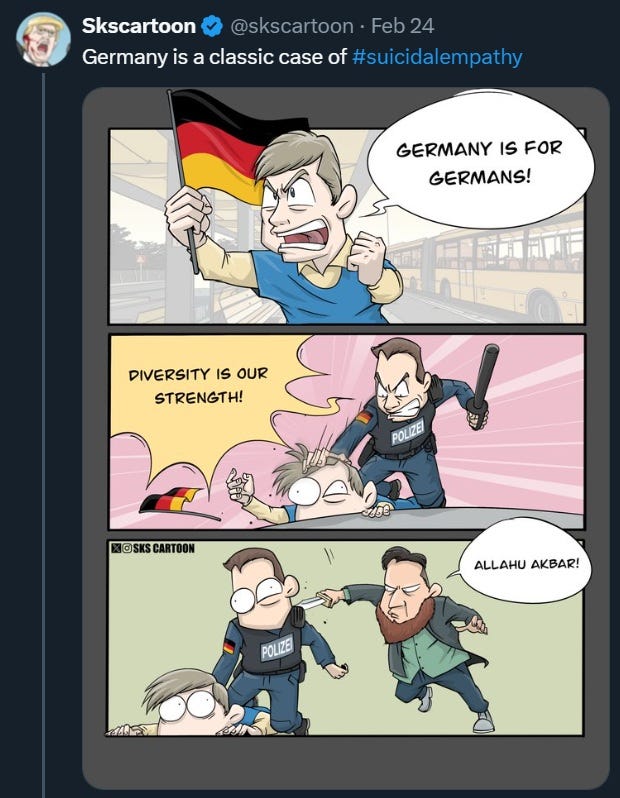
Elon has also said that “Modern Western civilization has extraordinary empathy compared to its power. This is also arguably its greatest weakness.” 7
This is closely related to another core New Right belief — that Westerners (i.e. white Christians) have voluntarily surrendered their homogeneous homelands to outsiders, while all of the world’s other civilizations, being less kind and empathetic than ours, have remained staunchly exclusionary. I can’t tell you how often I’ve heard rightists say things like this :
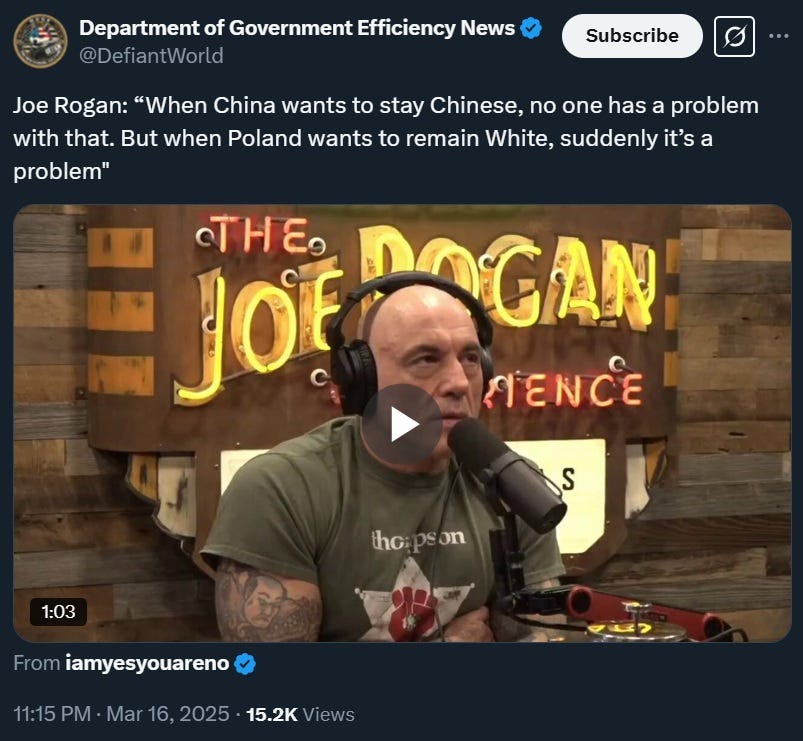
The New Right has a mental map of world civilizations that probably looks a lot like Sam Huntington’s (except with Russia and East Europe as part of the West). And they have this notion that all the other civilizations are basically hard-asses who forbid immigration in order to keep Muslim lands for the Muslims, China for the Chinese, and so on. Western Civilization, they believe, is uniquely nice (“empathetic”), and this niceness is a form of weakness, and so Western Civilization is unique in allowing itself to be overrun by outsiders. 8 This is also their explanation for why every homogeneous white place seems to turn into a bunch of blue-haired lefties.
It’s tempting to see this as just classic white nationalism, but I don’t think it’s quite that. Joe Rogan likes the idea of Poland being allowed to choose to “remain white”, but he doesn’t want to move there — or, I’m betting, to any homogeneously white place at all. Last I checked he lives in Austin, a deep blue city where whites are a minority . What he likes is the idea of some homogeneous, pure chunk of Western civilization, somewhere out there.
Elon Musk, meanwhile, loves the idea of AfD taking over Germany and making it “for the Germans” again. But he has also championed Indian immigration to the U.S. , and even threatened to “go to war” with other segments of the Right over this issue:
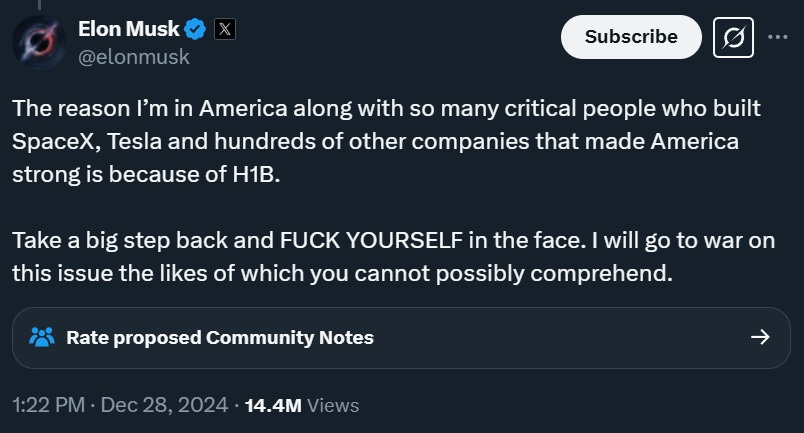
And of course, JD Vance isn’t angry that his wife’s parents were able to move to the U.S.
Thus, as tempting as it might be to see America’s New Right as the kind of racial-nationalist movement that existed in Europe in the 19th and early 20th centuries, it isn’t really that at all. It’s a de-localized, cross-border identity movement, similar to many other online identity movements .
America’s rightists aren’t really trying to enforce racial or religious homogeneity in their own back yards; their back yard is the internet itself. What they want for their own country is a memetic victory — they want the U.S. to acknowledge and venerate its European and Christian identity. And overseas, they want to know that someone, somewhere, is out there preserving an indigenous homeland for their identity groups. And that “someone” has to be Europe and the Anglosphere.
What the New Right wants from Europe and the Anglosphere
The perception that Western civilization was about to “fall” in the 2020s explains the desperate urgency that the New Right feels today — which helps explain many of the seemingly rash, self-destructive actions of the Trump administration. If Western civilization is to be preserved, wokeness must be purged from the U.S., even if it means doing some damage to the economy. And then the ancestral homeland must be reclaimed — European countries must be bullied into either expelling Muslims or forcing them to honor the idea of the West, and Christianity must be granted at least as much government protection and official recognition as Islam (and preferably more).
This is what JD Vance was trying to communicate in his recent speech in Munich:
[T]he threat that I worry the most about vis-à-vis Europe is not Russia, it’s not China, it’s not any other external actor. And what I worry about is the threat from within, the retreat of Europe from some of its most fundamental values…
I look to Sweden, where, two weeks ago, the government convicted a Christian activist for participating in Quran burnings…And as the judge in his case chillingly noted, Sweden’s laws to supposedly protect free expression do not, in fact, grant—and I’m quoting—“a free pass to do or say anything without risking offending the group that holds that belief.”…
And perhaps most concerningly, I look to our very dear friends, the United Kingdom, where the backslide away from conscience rights has placed the basic liberties of religious Britons, in particular, in the crosshairs…A little over two years ago, the British government charged Adam Smith-Connor…with the heinous crime of standing 50 meters from an abortion clinic and silently praying for three minutes…just silently praying on his own…[J]ust a few months ago, the Scottish government began distributing letters to citizens whose houses lay within so-called “safe access zones,” warning them that even private prayer within their own homes may amount to breaking the law…
And of all the pressings—challenges that the nations represented here face, I believe there is nothing more urgent than mass migration…The number of immigrants who entered the EU from non-EU countries doubled between 2021 and 2022 alone. And, of course, it’s gotten much higher since. And we know the situation, it didn’t materialize in a vacuum. It’s the result of a series of conscious decisions made by politicians all over the continent, and others across the world, over the span of a decade. We saw the horrors wrought by these decisions yesterday in this very city [in the car attack by Afghan immigrants]…
How many times must we suffer these appalling setbacks before we change course and take our shared civilization in a new direction? No voter on this continent went to the ballot box to open the floodgates to millions of unvetted immigrants…[M]ore and more, all over Europe, they’re voting for political leaders who promise to put an end to out-of-control migration.
He has also said that Europe is in danger of “civilizational suicide” .
What the New Right fundamentally wants Europe to do, I think, is not to spend a higher percentage of its GDP on the military, or make trading concessions, or whatever. What the New Right wants Europe (and the Anglosphere) to do is to go back to being the tough, hard-ass champion of racial homogeneity and Christian heritage that Americans imagined it to be before 2010.
That doesn’t mean the New Right demands that Europe ethnic cleanse itself of Muslims or make Christianity the state religion (though some certainly wouldn’t mind). What they want is for Europe to venerate these organizing principles . They want Europe to be vocally proud of its Christian heritage, and to prioritize the interests of white Europeans as the true sons of the soil.
This also explains the New Right’s respect and admiration for Russia. Sure, people in Russia don’t go to church , and they get divorced at high rates. But the Russian Orthodox Church supports Putin’s war in Ukraine, and the country hasn’t been inundated by Muslim immigrants. 9 So to the New Right, Russia feels like a much truer standard-bearer for Western Civilization than modern Europe does.
America’s New Right sees themselves and the Russians as the only two groups of hard-asses that Western Civilization has left — the tough marcher lords at the periphery who need to march back in and save the core from its own decadence and degeneracy. In a way, they see Europe and the Anglosphere as their aging, alcoholic father, and themselves as the son staging a needed intervention.
Thus, as long as the New Right is in power in the U.S., they will continue to push for Europe to elect rightist parties like the AfD, and punishing European countries if they keep not electing them — or at least embracing their ideas in a vocal and visible way. And they will continue trying to ally with Russia.
The New Right isn’t really so new
The New Right is new, but it has its roots in older movements. In fact, in many ways its older and more deeply rooted than the Reaganite conservatism of the 1980s and 1990s. In fact, it’s pretty similar to something we used to call “ paleoconservatism ”. From the Wikipedia page:
Paleoconservatives support restrictions on immigration, decentralization, trade tariffs and protectionism, economic nationalism, isolationism, and a return to traditional conservative ideals relating to gender, race, sexuality, culture, and society…Paleoconservatives see neoconservatives as imperialists and themselves as defenders of the republic.
That’s not too different from MAGA. And it’s very similar to Trump’s own personal flavor of New Right ideology — with the main difference being that Trump is philosemitic and a supporter of Israel.
In fact, this strain of thinking has always been important in American society and politics. The perception that Reagan’s coalition was a bunch of libertarians and neocons is a bit of rose-colored nostalgia; in fact, paleocons were an important if largely quiet bloc within the Reagan coalition. And even the libertarians of that era weren’t all a bunch of Milton Friedman or Ayn Rand types — a significant number were paleoconservatives who embraced libertarian ideas because they wanted white people to be free to self-segregate , or because they believed that in a fair economic contest between the races, the hard-working white man would come out on top.
In fact, every nation tends to have a movement like this. As Gary Gerstle writes , no nation in the world defines itself purely in civic, institutional, or ideological terms — there are always identity movements mixed in. The question of “Who are we?” always has multiple answers.
Where the New Right mainly differs from paleoconservatism is in its delocalized, online character. The paleocons of the 1930s wanted nothing to do with Europe; the New Right spends all day mainlining news stories about Muslim immigrants raping German girls, and arguing with European liberals on X. The paleocons of the 1980s wanted to allow white people to self-segregate in towns and schools; the New Right cares far less about the physical world, and far more about who wins the online status wars. 10
If you look closely at any policy championed by the New Right, you’ll see that it’s about online status. The paleocons of the 1980s might have wanted to keep Hispanics out of their own communities, but when MAGA people cheer the deportation of a few random Venezuelans , they know full well that those people never would have been their own neighbors. Instead, it’s all about status — it’s about proving that America’s leaders can simply pack migrants off to a foreign dungeon whenever they feel like it. The action draws a status distinction between the groups of the people being deported and the groups of people notionally doing the deporting. To the New Right, this is proof that Western Civilization can stand up for itself.
Ultimately, this is why I think that despite the superficial resemblance, the New Right’s domestic policy will be less destructive than the European racial nationalist movements of the 19th and 20th centuries. For an ethnonationalist in 1914, homogeneity was a geometry problem — what mattered was physical proximity, so you had to police the perimeter and purify the interior of your race’s plot of land. That led to border wars and genocides.
But for the New Right, there is no perimeter and there is no interior — immigrant crime in Sweden matters far more than whatever is happening next door in your actual physical town. If a MAGA fan’s town became 10% whiter, or people started going to church more, he wouldn’t even know it until some influencer quoted the statistics to him on X. The New Right is an online fandom , and its victories or defeats will all be online too.
What are the risks of the New Right?
Just because it’s a fundamentally online movement doesn’t mean the New Right will be harmless.
For one thing, Trump’s economic isolationism will harm American prosperity . To many on the New Right, this is an acceptable outcome — or even a desirable one. Reverence for Western Civilization — for the idea of place, homogeneity, and heritage — fills a deeply spiritual need for them. This is why they often scorn the idea of GDP as a measure of human flourishing — in the famous words of Captain Picard , they think that prioritizing economic outcomes means that our bellies will be full, but our spirits will be empty. Seeing Trump deliberately de-prioritize the grubby materialism of the economy thus feels like a kind of spiritual victory — a symbolic dunk on mammon and an elevation of the sublime. 11
And in the realm of foreign policy, the New Right is already causing a lot of chaos. Flipping America’s alliance from Europe to Russia has destabilized the international system in ways we’re only beginning to appreciate. For Ukrainians fighting for their country’s survival today, or for the Poles who may have to fight a similar battle tomorrow, America’s withdrawal is catastrophic. For the New Right, the instability is still mostly far away, but someday they may feel some real-world consequences, as America learns the downsides of going it alone.
But ultimately, I think New Right’s biggest weakness is that it just can’t accomplish its own objectives. Dunking on immigrants, Europeans, and the U.S. economy will provide the hot rush of memetic victory in the short term, but in the long term nothing will really change, and five or ten or twenty years down the line, all of the people the New Right despises will still be right there on social media, which is where they actually live. No matter how many migrants Trump keeps out at the border, the people on the New Right will still spend their days interacting with foreigners online.
The New Right venerates place, rootedness, and homogeneity, but as a fundamentally online movement, it can’t actually get any of those things. Trump is striking out in meat-space against enemies in meme-space, but the power of those strikes is limited. In lieu of an American equivalent of China’s Great Firewall, I don’t know what could possibly give the New Right a nation of their own. 12
The human race is only beginning to adapt to the delocalization of community, conversation, and ideas created by social media. The New Right is an initial, instinctive reaction to that wrenching technological change — people seeking solace in the online maelstrom by clutching at the dream of a kind of localized, rooted civilization that increasingly exists only in the past. I doubt it will be the last such reaction, or the strangest.
Whatever


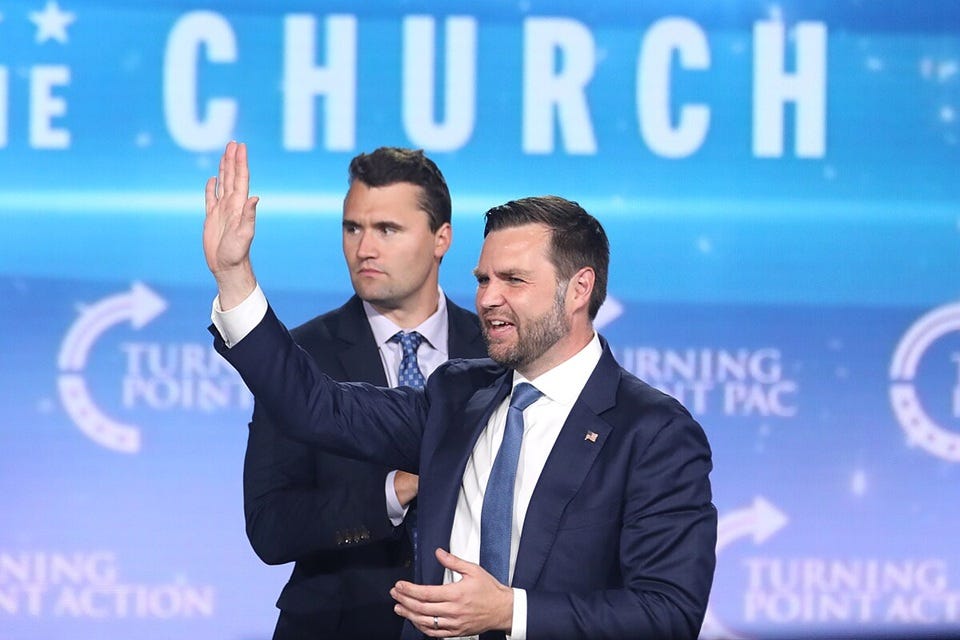
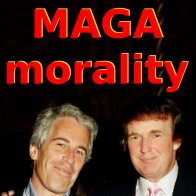




This is long, and requires thought.
It is worth the time and effort.
Fine article, and I read all of it.
But this is too deep to explain the average MAGA, whose ideology can be boiled down to a few words - "the great replacement" conspiracy theory. America has always been by default a "white" country, and demographics are going away from that. The MAGA types began to see that when Obama ascended, in fact that is what caused the Tea Party movement and birtherism. They cant bear the thought of people who look like them being the minority.
... which explains MAGA's urgent need to expel Black and Brown.
It's hilarious, here in Yuma, to hear complaints about Hispanics. ... Who were here long before us Anglos.
Your article argues the exact opposite:
Is that not what he is trying to achieve?
I think this article makes the assumption that the term "nationality" is in transition from a concept of physical community (the nation-state,i.e.,"meat-space"), to a disassociated, ethereal "meme-space" based on www.(InsertNationHere).net, and it is the reaction to this bifurcation of identity that is driving the psychotic behaviors of the Trump administration and supporters of the same.
I think that that might be the reason that people are supportive of the Administration, but to Trump himself I think it is all about amassing power.
Probably. Although I'd be astonished if it was thought out. Instinct from a carney barker... yes.
Therefore the zillionaires' purchases of media.
Cognitive dissonance strikes again.